Ukraine National Medical University Embryonic Stem Cell Research Centre
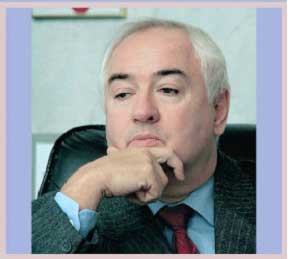
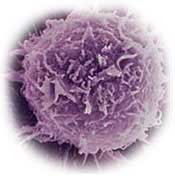
Introduction:
- Ukraine National Medical University’s Professor.
- Ukraine Embryonic Stem Cell Research Centre’s chairman.
- Founder of Ukraine National Medical University Stem Cell Therapy and Embryonic Stem Cell
Research Centre.
• In 1994, under the legal approval by the Ukraine health Ministry, established the world’s first Human Embryonic Stem Cells Treatment Centre.
• Obtain 21 international patents.
• Over 210 clinical programs of using embryonic stem cells.
• Awarded by Oslo for advanced medical work.
• 21 years of experience in using different doses & mixture of embryonic stem cells in the treatment of different diseases such as diabetes, AIDS, aging etc.
• By 1994, over 8000 cases have been treated over a period of 25 years.
• Among the various diseases, embryonic stem cells have achieved better results than other types of treatment in terms of depth, quality & specificity.
• Professor Alexander Ivanovich Smikodub from the world’s only stem cell therapy hospital has published over 100 articles in Ukraine, Poland, Germany, Holland, Sweden, U.K., Ireland, South Africa, France, Romania & Denmark & received international recognition.
• Professor Alexander Ivanovich Smikodub’s research on stem cell therapy has contributed to doctor’s understanding & broadening of their views on the traditional method of treatment of diseases.
Stem Cell’s Purpose & Origin
Stem cells are the mothers of all the cells in the body. Stem cells can multiple & under different messages received, differentiate into 200 different types of body cells, eg: heart, skin, nerve & blood cells.
When fertilization occurs between a sperm & an ovum, the fertilized ovum will quickly multiple to form a morula and then a blastocyst, and three to eight weeks later an embryo. Three types of cell layers are formed: ectoderm, mesoderm & endoderm. The Ukraine Stem Cell Centre will separate out the three groups of cells.
The Rational for Stem Cell Therapy?
In the theory when stem cells are transplanted into the body, they will according to the needs of the body differentiate & multiple into the cells or organs the body needs. They can treat bone marrow, immune system, nervous system & various chronic degenerative diseases.
The Sources of Stem Cells
1. Adult Stem Cells: found in various organs, but their numbers are few, & their powers of
regeneration are lower.
2. Cord blood stem cells: good for blood & immune system disorders.
3. Embryonic stem cells: embryo has large number of stem cells. They have high ability to differentiate, since immunity has not been established, then will not has immune rejection problem.
Different Ways of Using Stem Cells
1. Stem cells from different person.
There is a problem of rejection.
2. Stem cells from self.
There is no problem of rejection. But adults have few stem cells & their ability to differentiate is limited.
3. Human embryonic stem cells.
Embryonic stem cells are non-antigenic & have no immune rejection problem. They have great power of multiplication & can differentiate into all the different types of cells the body needs. This is the ideal stem cell for therapy. The Ukraine Medical University Research Centre is using this type of stem cells for therapy.
4. Cord blood stem cells.
They are useful for only blood system disorders. They have a 50% chance for use by parents, 25% chance for siblings, & approximately 1 in 50,000 chance for unrelated people.
5. Animal stem cells.
There is a problem of rejection. Its use is still being debated.
Different layers or types of embryonic stem cells:
Human embryonic stem cells can be separated into three layers or types:
1. Endoderm: The cells will develop into lung, thyroid, parathyroid, bladder, kidneys, genital
system, intestines, liver & pancreas.
2. Mesoderm: The cells will develop into skeletal-muscular system, adrenal, lymphatic
system, heart & the vascular system.
3. Ectoderm: This layer develops into skin, nervous system, eyes, and ears.
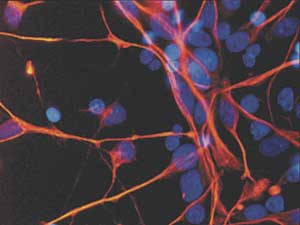
How is the Embryonic Stem Cells being Given?
A. Source: The embryonic stem cells from the Ukraine
Medical University are from human source.
(Donors must be voluntary & must have signed an agreement paper)
B. Three ways of giving the stem cells:
1. By intravenous injection
2. By intramuscular injection
3. By Laparoscopic organ injection
E.g.: People with nervous system disorder will be given stem cells from the ectoderm layer. People with heart disease will be given stem cells from mesoderm layer. Sometimes combination are given.
C. Stem cells are preserved at minus 196 ºC of temperature. They are thawed when ready for
use.
The Power of Healing by Embryonic Stem Cells
Embryonic stem cells surface has many Chemokine receptors. Chemokine is a protein which is released by a damaged part of body calling for help. When the chemokine attach onto the receptors of the stem cells, these stem cells will travel to the damaged tissue or organ to start repairing work.
The Safety of Embryonic Stem Cells
1. The donors must be healthy & have been carefully selected & screened for illness.
2. All donors are DNA screened to ensure no genetic diseases are present.
3. Many years of clinical experience have shown that the embryonic stem cells help to heal
diseases, they do not affect the genetic system of the patients.
4. Ukraine Medical University’s stem cell unit has since 1994, in 25 years, treated over 8000
cases with good clinical results & no side effect. Cases include diabetes, multiple sclerosis, cancers, heart disease, arthritis, SLE, Gynae disorders, muscular dystrophy, auto-immune disorder, neurological disorder, Mediterranean blood disorder. AIDS & various organ disorders. The research centre obtained the recognition & permission from the Ukraine Health Ministry (MPHA). It also holds 22 patent rights, including in USA, Holland, Ukraine and in other European countries.
5. When embryonic stem cells are transplanted into the body, there is no immune rejection.
They circulate in the blood & end up in the diseases organ when they multiply and replace the diseased tissue & restore the organ.
The difference between organ transplant & embryonic stem cell transplant
Organ transplant treatment has been used for heart, kidney & bone marrow for some years. It faces the major problem of immune rejection. The patients have to take immune suppression drug for life. In embryonic stem cell transplant, the stem cells rebuild the diseased organ to normal, there is no immune rejection, & therefore no need to take the immune suppression drug. It is convenient, & the treatment can be repeated.

The Ukraine Medical University’s embryonic stem cell treatment plan
A. Some examples:
1. Anti-aging
2. Menopausal syndrome for male & female
3. Premature aging
4. Chronic fatigue syndrome
5. Anxiety-stress syndrome
B. Diabetes
1. Insulin dependent diabetes
2. Non-insulin dependent diabetes
3. Labile diabetes
4. Diabetic induced nephropathy
C. Liver disease
1. Chronic hepatitis
2. Liver Cirrhosis
D. Kidney disease
1. Chronic renal insufficiency
E. Sexual dysfunction
1. Erectile dysfunction
2. Sexual weakness & dysfunction
F. Joint disease
1. Chronic arthritis
2. Mono or polyarthritis
G. Connective tissue disease
1. Rheumatoid arthritis
2. SLE
H. Neurological disorders
1. Senile dementia
2. Parkinson’s disease
3. Brain damage (from surgery or accident)
4. Insomnia
5. Muscular dystrophy
6. Multiple sclerosis
I. Blood disorders
1. Anemia
2. Leukemia
3. Leucopenia
4. Platelet deficiency
5. Acute or chronic leucocytosis
6. Lymphoma
J. Intestinal disease
1. Ulcerative colitis
2. Crohn’s disease
K. Cancers
1. Embryonic stem cells therapy can help cancer patients with their complications
such as anemia, inflammation & injection.
2. Reduce the unwanted stress from radiotherapy & chemotherapy to achieve the
final results.
3. Improve the immune system during the recovery process.
4. Prolonging the life of cancer patients.
L. AIDS
Embryonic stem cell therapy will help all the immune deficiency disorders including AIDS (Acquired Immune Deficiency Syndrome). AIDS patients after treatment will find their cells CD4 & CD8 increase in number indicating improvement.
Asian are fortunate, we hope those who need treatment can personally go to the Ukraine Medical University Embryonic Stem Cells Treatment Centre to receive treatment from world’s authority on stem cell therapy.
Dr. Alexander Ivanovich Smikodub & his team of research workers have 25 years of experience in treating over 8000 patients.
The following results have been reported by the Ukraine Stem Cell Treatment Centre for their patients:
1. Body system improvement – Effects seen within few hours to 1 – 4 weeks.
2. Nervous system improvement – Effects seen within few hours to 5 – 6 months.
3. Quality of life improvement – Effects seen within one week to 5 – 6 months.
4. Damaged organs improvement – Effects seen within one month.
5. Depression & insomnia – Improvement within 3 – 6 months.
6. Nervousness & anxiety – Improvement within 3 – 6 months.
7. Restoration of vitality – Improvement within 3 – 6 months.
8. Memory – Improvement within 3 – 6 months.
9. Quality of sleep improvement – Improvement within 3 – 6 months.
10. Energy level – Improvement within 3 – 6 months.
11. Skin quality improvement – Effects seen within 1 – 8 weeks.
In 1994, Ukraine Medical University’s Professor Dr. Alexander Ivanovich Smikodub M.D., Ph.D. established the Stem Cell Research Centre, and has accumulated many years of clinical experience with the use of embryonic stem cells.
He has published over 100 articles on embryonic stem cell therapy on the clinical treatment that includes heart disease, intestinal disease, blood disease, cancer, genetic disease, neurological disease, reproductive system disease, infection, auto-immune disease, endocrine disease & muscular disease. Also in 1993 he treated 49 aging patients & recorded the following report:

At a later stage, he made the following conclusion regarding the effects of stem cells in anti-aging, including changes that were observed post-treatment:
Evaluation was made on the improvements of fat distribution, lens opacification, glucose homeostasis, hormones level, lung elasticity and chest wall stiffness, SA node automaticity, hepatic function, gastric acidity, colonic and anorectal function, bone marrow function, immune system (T-cell function), glomerular filtration rate (GFR), vaginal mucosal atrophy, physical capability, muscle, bone density, etc.
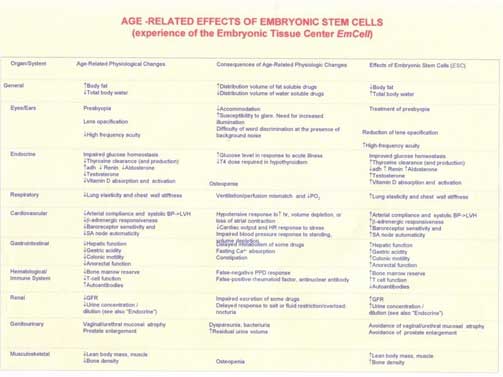
Furthermore, laboratory results shows increase of hormone level in blood serum after stem cells transplantation:

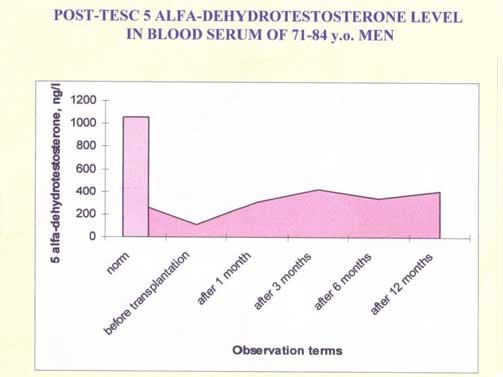
The following is a letter by a 72-year-old French, dated February 10, 1997, regarding the remarkable effects of stem cells therapy:
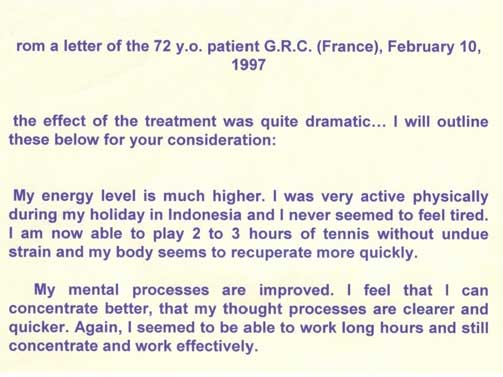
潘芳蘭博士
Dr. Pan Fan Lang
Initial Script: May’2005
Amended Copy: Aug’2007